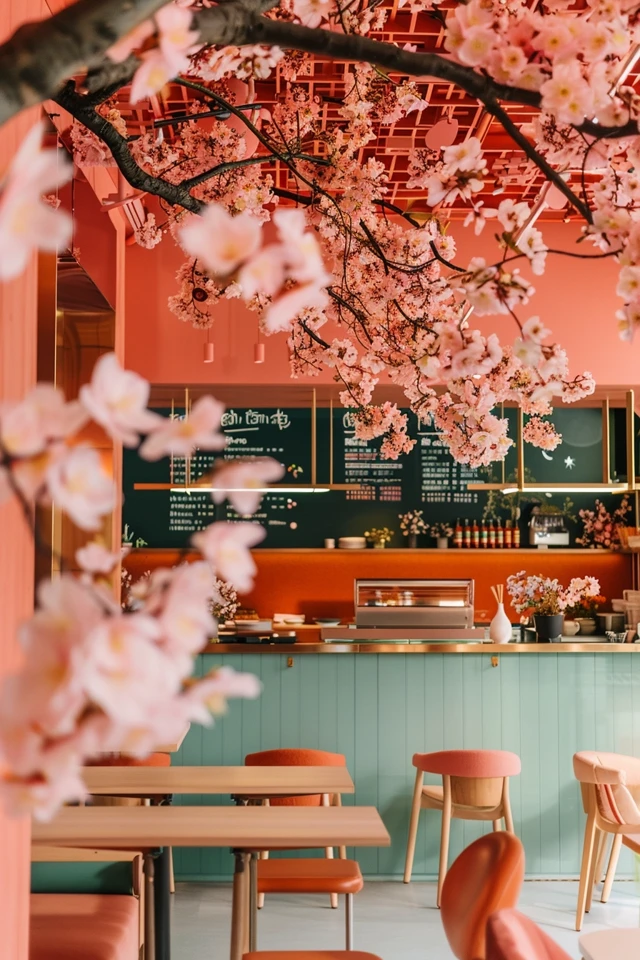Creating a captivating dining experience starts with your ceiling design. By using Japanese design principles, you can make your restaurant more welcoming. Here are five tips for a stunning Japanese restaurant ceiling:
- Incorporate the Japandi aesthetic: The Japandi style is a mix of Japanese and Scandinavian designs. It’s becoming popular in the US. This blend creates a peaceful and balanced space.
- Emphasize simplicity and neutral palettes: Japanese design loves simplicity and soft colors. Choose simple colors and patterns for your ceiling for a clean look.
- Use natural materials: Incorporating natural elements like wood, stone, and glass is typical in Japanese interiors. Using wooden boards for your ceiling adds warmth and authenticity.
- Create a decluttered space: A serene environment is key in Japanese design. Keep your ceiling free from too much decoration or lighting.
- Consider symbolic decorations: Traditional Japanese spaces have meaningful decorations. Add paper lanterns or bamboo touches for cultural depth.

Key Takeaways:
- Blend Japanese and Scandinavian styles for a peaceful atmosphere.
- Choose simplicity and neutral colors for your ceiling.
- Bring in natural materials for authenticity.
- Avoid clutter for serenity.
- Add meaningful decorations for cultural richness.
The Importance of Japanese Design Principles in Restaurant Ceilings
Incorporating Japanese design principles into restaurant ceilings can deeply transform the space. These principles focus on simplicity, harmony, and a natural connection. This creates an inviting, calming atmosphere. Embracing these ideas can improve the dining experience, making your restaurant stand out.
Japanese design features clean lines, rough textures, neutral colors, and minimalism. It champions the idea that “less is more.” This minimal approach fosters tranquility and keeps the focus on what’s important.
The Japanese concept of “ma” highlights the beauty of empty space. In ceilings, this could mean using skylights or open areas. It allows natural light to come in, making the space feel larger and more open. This strengthens the sense of being connected to the outdoors.
Natural materials like wood, stone, and glass are often used in Japanese interiors. Including these in your restaurant’s ceiling can bring the outside in. It creates a warm, organic setting that diners will find harmonious.
Functionality is also key in Japanese design. It often mixes the inside space with the outside, through big windows or sliding doors. This not only offers great views but also adds to the feeling of openness. It gives a sense of freedom to guests.
Japanese decorations are chosen with care and placed purposefully. Adding specific decorative items to your ceiling can amplify the atmosphere. It makes the space visually appealing for your guests.
To sum up, using Japanese design in restaurant ceilings is vital for an immersive dining experience. By valuing simplicity, harmony, and nature, you can boost your restaurant’s appeal. This creates a memorable experience for your customers.

Practical Considerations for Japanese Restaurant Ceiling Design
When designing a Japanese restaurant’s ceiling, think beyond looks. It’s essential to consider practical elements for a design that works well and enhances dining. Here’s what to keep in mind for your ceiling design:
- Acoustics: Use sound-absorbing panels or materials to lower noise levels. This creates a quieter, more comfortable space. It helps customers talk easily without loud distractions.
- Maintenance: Select materials that are simple to clean and maintain. In a busy restaurant, an easy-to-clean ceiling saves both time and effort.
- Fire Safety: Make sure your ceiling materials meet fire safety standards. Use fire-resistant materials and plan for fire sprinklers or suppression systems.
- Lighting Efficiency: Use LED or energy-efficient lighting to cut energy costs. Efficient lighting also helps set a beautiful ambiance.
- Cultural Reflection: Add elements of Japanese culture to your ceiling. Traditional patterns, artwork, or symbols can offer an authentic Japanese dining experience.
Incorporate these practical tips to ensure your Japanese restaurant’s ceiling is visually impressive, functional, and memorable for diners.

Conclusion
Designing a Japanese restaurant ceiling means blending Japanese design ideas with practical needs. This mix creates a special dining experience. By adopting the Japandi look, using natural materials, and valuing space, you create a true Japanese feel.
Also, picking suitable lighting and showing Japanese culture adds to the atmosphere.
Don’t forget about sound quality, ease of care, fire safety, and efficient lighting when planning your ceiling. Balancing looks and functionality makes your dining space unique. This sets your place apart.
If you’re on a tight budget, you might consider a food truck theme. For something upscale, think about adding a vintage wine collection. Market research and budgeting should guide your theme selection. Pop-up restaurants offer a fun, short-term option.
Interior design themes are vital for making your restaurant appealing, not just the food. Considering what customers want, where you are, and nearby competition helps. Choose a theme that speaks to your audience and ensures your restaurant thrives.

